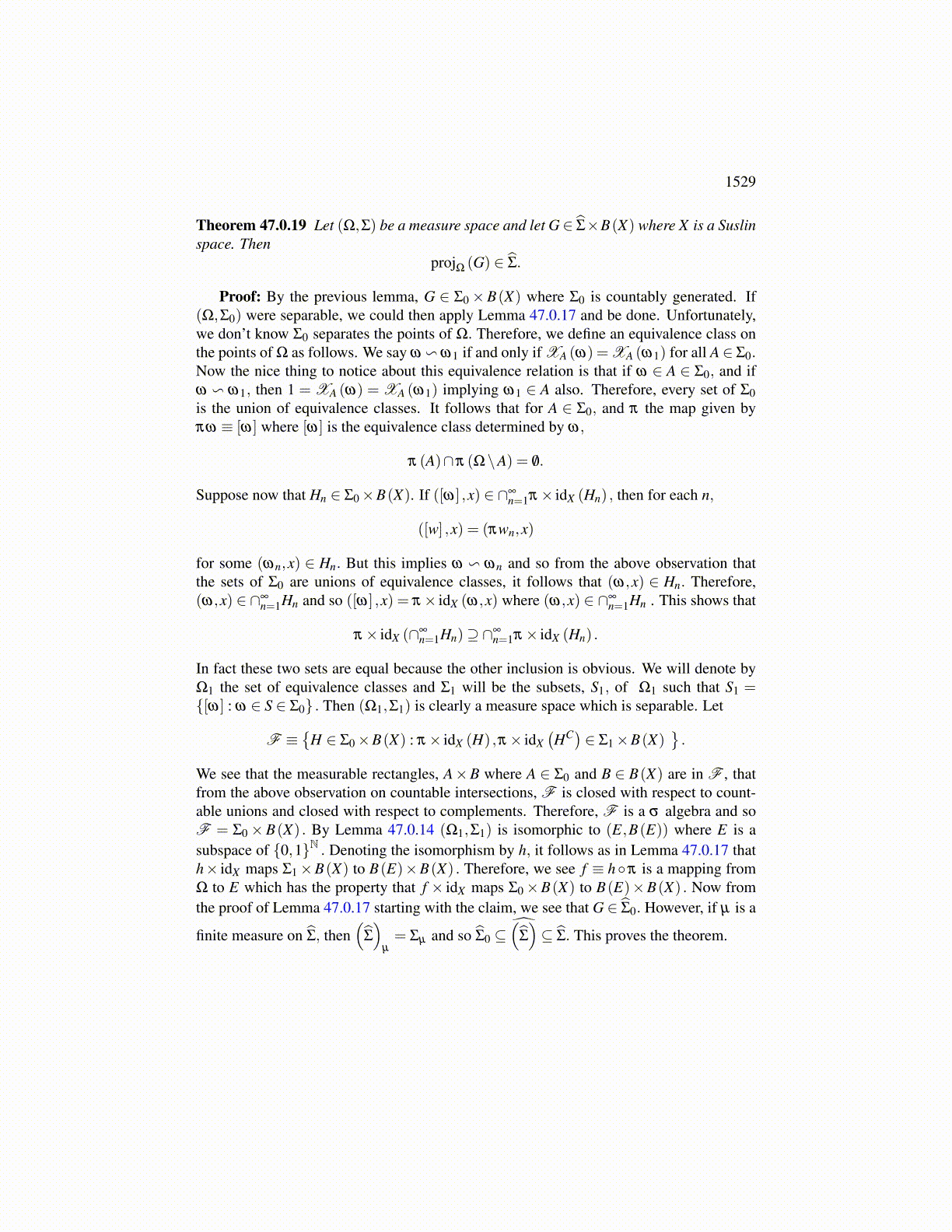
1529
and µ(φ−1 (N)
)= 0. Therefore, φ
−1 (A) ∈ Σ1µ and so if F ∈ Σ̂2, then
F ∈ ∩{Σ2ν : ν is a finite measure on Σ2} ⊆ ∩{
Σ2φ(µ) : µ is a finite measure on Σ1},
and so φ−1 (F) ∈ Σ1µ . Since µ is arbitrary, this shows φ
−1 (F) ∈ Σ̂1.The next lemma is a special case of the Yankov von Neumann Aumann projection
theorem. It contains the main idea of the proof of the more general theorem.
Definition 47.0.16 Let (Ω,Σ) be a measurable space and let G ∈ Σ×B(X) the productmeasurable sets resulting from the Borel sets B(X) for X a Suslan space. Then
projΩ (G)≡ {ω ∈Ω : there exists x ∈ X with (ω,x) ∈ G}
What if you had G = ∪{(ω×A(ω)) : ω ∈Ω} where A(ω) is in Y some polish spaceand A(ω) is, for example, a closed nonempty set? Then
projΩ (G) = {ω ∈Ω : A(ω)∩X ̸= /0}
Of course, you might ask whether this particular G is in Σ×B(X). For fixed ω the ω
section is closed which is Borel. To say that projΩ (G) ∈ Σ would be to say that each ysection is in Σ so this G is in Σ×B(X) exactly when projΩ (G) ∈ Σ. Later this will bedefined as saying that A is a measurable multifunction. It will be measurable when X isopen, strongly measurable when X is closed.
Lemma 47.0.17 Let (Ω,Σ) be separable and let X be a Suslin space. Let G ∈ Σ×B(X) .(Recall Σ× B(X) is the σ algebra of product measurable sets, the smallest σ algebracontaining the measurable rectangles.) Then
projΩ (G) ∈ Σ̂.
Proof: Let f : (Ω,Σ)→ (E,B(E)) be the isomorphism of Lemma 47.0.14. We have thefollowing claim.
Claim: f × idX maps Σ×B(X) to B(E)×B(X) .Proof of the claim: First of all, assume A×B is a measurable rectangle where A ∈ Σ
and B ∈ B(X) . Then by the assumption that f is an isomorphism, f (A) ∈ B(E) and so
f × idX (A×B) ∈ B(E)×B(X) .
Now letF ≡ {P ∈ Σ×B(X) : f × idX (P) ∈ B(E)×B(X)} .
Then we see that F is a σ algebra and contains the elementary sets. (F is closed withrespect to complements because f is one to one.) Therefore, F = Σ× B(X) and thisproves the claim.
Therefore, since G ∈ Σ×B(X) , we see
f × idX (G) ∈ B(E)×B(X)⊆ B(E×X) .